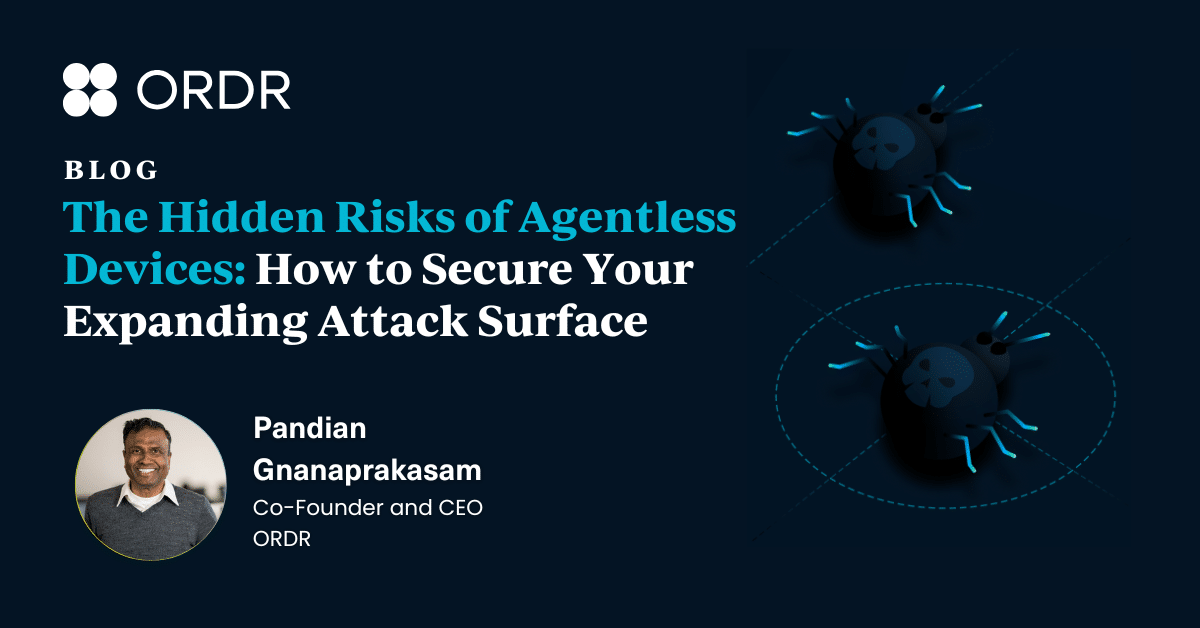A little background on why I’ve agreed to do this guest QA blog for Ordr:
In my role as CTO at CDW Healthcare, I talk to former healthcare peers, in an advisory capacity, to help them protect patient safety and resources with the best cybersecurity technology solutions. Prior to joining CDW, I was CIO of Halifax Health where we deployed Ordr for our medical device security needs
I’ve been at CDW for slightly more than two years, after more than two decades in the healthcare trenches, most recently as the former CIO of Halifax Health. I decided on a different role at CDW to bring best practices and cybersecurity technologies to my CIO colleagues who are on the forefront of fighting the cyber war. If the healthcare industry could more effectively collaborate and share security expertise to mitigate cyber-attacks, we would stand a much better chance against the cyberattacker army working together against us every day!
What is your primary goal as the CTO of CDW Healthcare Division?
To bring awareness to our healthcare customers on the importance of bringing modern IT tools into healthcare organizations to optimize patient safety and hospital resources. With Ordr’s cybersecurity solution there are many ways network visibility helps hospitals beyond, of course, ransomware, but also what’s happening with device utilization, what’s happening with compliance and what’s being communicated externally. There are several important use cases we want to advise our customers about to develop a proactive plan before something bad happens.
Why is IoT and connected device monitoring and enforcement so unique for hospitals?
There’s a problem with biomed devices and it’s not going away. There will always be biomed devices that have outdated and unsupported operating systems. In the beginning, when first purchased, they were of course running mainstream and perhaps even state of the art operating systems, but now these operating systems are no longer supported by the manufacturers. As a result, O/S patches are no longer available to address vulnerabilities, even though these devices are still within their useful lifecycle and are still viable, delivering strategic care for patients and revenue to healthcare organizations.
Why weren’t patches performed on outdated operating systems on biomed devices?
Unfortunately, this is due to the biomedical industry. As a medical device design engineer for ten years, I may have helped cause the problem, although we thought it made sense the way we did it back then. We would buy an off the shelf computer and put it in a cabinet or a device we were creating, and it would run it. The computer we installed ran whatever the latest operating system was at the time. The issue back then was per the FDA 510k rules for class two, and three medical devices once the device was tested, it could never be altered. This included the operating system on the off the shelf computer. So, the manufacturers never changed them or patch the OS because they could not!
Can you patch today?
In 2016, the FDA reversed their guidelines and said you can patch devices now because it is important to upgrade operating systems. But it was a guideline, it was not a mandate. Because it was a guideline and because it is hard for biomedical manufacturing companies to transition to have a global patch program for all the devices they sell, they do not do it. And they do not want to release the product to an IT team to open it up and obviously, upgrade the operating system or patch it due to inherent risk on their part, because it might make their system not work properly.
Bottom line, the problem is going to persist because biomed devices will continue to outlast the useful life of their operating systems and CFOs do not want to replace a $4M imaging device that makes the hospital money every day only because it has a security vulnerability.
If you don’t patch what can the CISOs and security leaders to do?
They are stuck, because now they have a known vulnerability in their system, and they must do something about it. This is the reason I was introduced to Ordr.
How did you select Ordr for addressing the patching issue?
To get the security and network teams to completely agree on something was amazing.”
Our first step was to do a POC (proof of concept) by my IT security team. A few weeks later, my network and security team had a meeting with IT leadership to show the results of the POC. We were all blown away. I’ll never forget that moment because everyone was happy, even joyous which doesn’t normally happen with software in general.
To get the security and network team to completely agree on something was amazing, because normally, they have a little contention just due to their job functions where one wants data to flow, and the other one wants to control data.
Once deployed, did you meet your objective?
One of the major tenants of cyber security is to understand your landscape. And that includes all devices connected to your network. Are they patched? Or are they outdated and unsupported?“
I was amazed. Ordr worked and it worked well. We purchased Ordr originally because I knew I had a problem with older biomed devices running Windows XP. Before Ordr, our vulnerability scans would find them but then they would disappear because of their dynamic nature of how they connected to the network. And if we didn’t find them that very minute and physically locate them, we would lose sight of them. It was a real problem. We could not see and didn’t know our full landscape. And that is scary, because to me, one of the major tenets of cyber security is to understand your landscape. And that includes all devices connected to your network and their patch status. Are they patched? Or are they unsupported? It is not just your IT devices, it is anything that is connected to your network. As you know, in the last five years, that’s grown greatly with so many other things connecting now, and you still have these legacy biomed devices that are out there too.
How did you manage all the outdated and unsupported biomed devices you found?
When we fully deployed Ordr, we noticed a couple of things right away. First, we not only found all the biomed devices, but we also now had an inventory of them. And we were able to understand what operating systems they were running and could have a plan of what to do about it. At that time, we had three choices.
- Replace the device. But again, financially that might not be viable.
- Get the manufacturer to patch it, or to upgrade the operating system so it was no longer vulnerable.
- Bury it by micro segmentation. Through micro segments, you have controls around it from the internal firewall, Even though we have controls, you still need to monitor it and we used Ordr.
When I would talk to people, they understood Splunk monitors user behavior. Ordr monitors device behavior. I can now set upper or lower limits on the device itself. And if Ordr detects something odd, we can be alerted
What was the next step to managing these vulnerable devices?
If the hacker gets in and gets to an XP device, that would be the biomed device, it takes about 20 minutes for them to own that device. If the device is connected to a server, then they can own the network.”
The roadmap was moving more towards enforcement and that sat well with me. The reason why is that hackers do not attack during the day, they tend to attack at night and on weekends. At those times, depending on what hospital you’re at, you might be relying on a managed Security Operations Center (SOC), which is pretty good. Or you might be relying on your on-call staff to fight any cyber problems in the middle of night. And there’s latency in that. If the hacker somehow gets in and gets to an XP device, it takes about 20 minutes for them to own that device. If there are any servers connected to that kind of device, then they have the opportunity to own the network. Now the world turns bad quickly. To have a system that has deep understanding of proper network communication related to strategic IoMT devices and can monitor those devices 24/7and alert us when something is wrong, is great.
Next, if I could actually enforce policy, or at least send API commands from Ordr to change the policy in my firewall or my NAC, these devices could shut down communication at 3 am in milliseconds. This is much better than the time it would take the team to figure out what the problem was, based on a calls to the service. IoT and connected device security enforcement can stop a virus from propagating
What else could you do now with full visibility of your network landscape?
Device utilization is a big deal. Ordr creates custom views per departmental stakeholders. For example, the Biomed and/or Operations team could go into their Ordr view and just look at medical device utilization. Their view doesn’t allow them to see the other aspects of cyber or network information Ordr was capturing.
I like to tell the story that if a clinician wants another ultrasound device in your hospital, but your ultrasound fleet is only being utilized 30% of the time, you do not need another ultrasound, you need to improve your processes to get better utilization of your devices. And when you do this, you save money by not buying another device while improving your processes. And so that is valuable.
For some devices, Ordr was monitoring down to the battery life level. Since we all know batteries go bad, to have an alert to the Clinical Engineering team for low batteries on biomed devices is cool and important.
The next important outcome we gained is forensic device data. Ordr collecting all device data in the cloud. When we have a potential security incident, we called the security team. The team uses Ordr to determine what device was bad and see who it was talking to and how it was talking, to see if it was doing things that it should not do. We always used Ordr during any security incident as part of our incident response toolbox. And it worked well. And even the network team liked it because Ordr does an incredibly good job of showing how everything communicates, and what it is trying to communicate and what is being blocked from communication.
To sum it up, first and foremost the outdated and unsupported biomed devices are a problem that is not going away, ever! Operating systems only have a life for so long, so you need something to address the issue. With Ordr though, you get more use cases including device utilization management, forensic data and the network team gets to see how things are communicating, outside of their regular forensic toolbox. So that’s why I like Ordr.

Interested in
Learning More?
Subscribe today to stay informed and get
regular updates from ORDR Cloud



